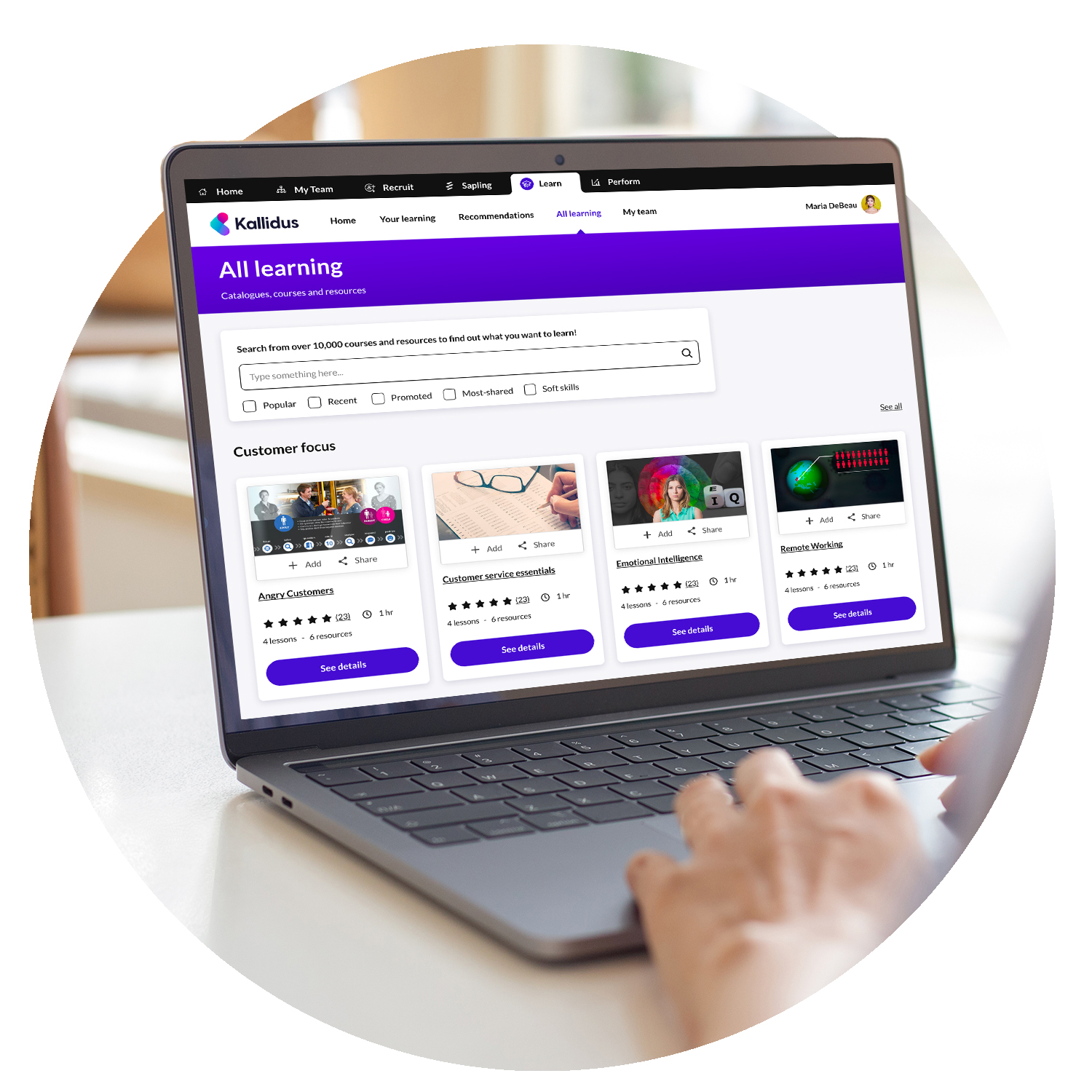Following the incredible engagement in the webinar and all the great questions asked during our session that we didn’t quite have time for, Sian Parr and Brett Gillman have carefully answered each question below.
Whether you joined us live or are still yet to watch, take a look below to learn more about how to address diversity issues in eLearning, representing hidden diverse characteristics, and finding out whether your inclusive efforts could be deemed offensive.
.embed-container { position: relative; padding-bottom: 56.25%; height: 0; overflow: hidden; max-width: 100%; } .embed-container iframe, .embed-container object, .embed-container embed { position: absolute; top: 0; left: 0; width: 100%; height: 100%; }
Q:Other than using characters and eLearning content, what accessibility standards should you put in place to be inclusive?
Brett Gillman: The more accessible the content that you create, the better. I’d start by looking at the learner group and determining the level of accessibility that is required because this might inform what software or authoring tools should be used.
Sian Parr: I agree with Brett; Focus Groups or Training Needs Analyses are a great way to establish requirements for your learners. No one can tell you what they need out of learning more than your workforce! In terms of the types of accessibility elements we use within our modules, as a standard, we always ensure Closed Captions are included. We also create accessibility documents for visually impaired learners to use with screen readers for many of our customers.
Q:You can portray different ages, genders, and races, but how do you portray sexuality or transgender without stereotypes that can be offensive?
SP: Sexuality and transgender identity are what I call ‘invisible diversities’, along with mental health and various other disabilities. In other words, unless someone openly tells you their sexuality or the fact that they have undergone gender reassignment, it may not be obvious at all. On that basis, if I were looking to cast someone or create a character with this background, I wouldn’t deliberately go out of my way to emphasise this element, but I would tie it into the story if it were needed within the content (for instance a D&I module). If an ‘invisible diversity’ of any kind were to be factored into content, you do run the risk of actually having to be stereotypical so that the character’s backstory is obvious, so it needs to be handled sensitively and carefully.
BG: You’re right to be wary of unintentionally creating/reinforcing stereotypes through the visuals used or approach to learning design. I don’t have a set rule on this other than encouraging you to consider whether you’re telling a diverse story. Does it feel right to you? Maybe seek out the views of other people if you’re still not sure. Also, be open to feedback and amending content on the back of this.
Q:When you are creating internal content for your organisation/ employees on any topic that isn’t directly linked to diversity and inclusion, what is the most important thing you should consider before building out that narrative and/or scenarios?
SP: For any content, internal or otherwise, I try to think about whether I would like to be the end-user of this content. As a Learning Designer, one of the tasks we have is to think about how the content will deliver itself. Will users understand the content? Does it flow properly? Is it engaging enough? And one of the most important questions we have to ask is, will the content land without causing offence?
BG: The three steps that we referred to in the webinar are a good place to start. Think about your own position; look beyond your own perspective; tell diverse stories. You can actually apply this approach to all sorts of topics because what you’re asking yourself is ‘am I doing this subject justice?’, ‘what are my gaps in telling this story/covering this content?’.
Q:We find it difficult to ‘justify’ asking the questions of employees and our service users regarding sexuality, sexual orientation, religion etc so don’t really know if we are or are not diverse in our reach etc. How would you suggest we pose the questions to find out where we are now so as to measure how we can improve?
SP: It’s my strong view that conversations surrounding Diversity and Inclusion should be done in a safe and honest space. Asking what could be considered ‘probing’ questions may run the risk of causing offence, but how are you really to understand people’s views on what you’re doing right or wrong without asking the questions in the first place? I designed some eLearning for my previous employer, and spent two days holding focus groups with a range of diverse employees, asking them questions that related to the module I was designing and where they felt they needed to be represented more or were being over-represented. This was a big help for me and was very well received by the employees who felt their voices were being heard.
BG: I think people are more likely to respond if they understand the context in which you’re asking them the questions. For example: creating content that feels real to your users and reflects challenges/their experience.
Q:What techniques can you use to represent older people?
SP: I think it really depends on the content to be honest. What message are you trying to deliver whilst representing older people? What does the content relate to? Creating character profiles often helps as you can build a story for the people you are including in your module. By understanding these elements, it helps you create the right representation for this demographic.
BG: I think the same approach applies for representing older people in content applies: recognising the position in which you are coming from may be different and finding ways to fill the gaps in your knowledge. Researching challenges and perspectives from this group will help ensure your stories resonate. I think that’s going to be more impactful than thinking about the types of images you’ll include.
Q:I work with young people with learning difficulties. Their looks and behaviour don’t tell their story, how could we depict this?
SP: Again, this relates back to what I mentioned previously about ‘invisible diversities’. I would be careful not to go overboard with their story through their appearance and behaviour (unless this is relevant and necessary) and spend more time focusing on telling their story through the content.
BG: I think this area is often overlooked and it shouldn’t be. We should be factoring in more subtle/hidden diversity in the content and stories we tell. The closer you can get to depicting the actual challenges that people go through the better the end result. If you have gaps I’d recommend researching, and even better, spending time with the people whose stories you want to tell.
Q:Like many people, I am working remotely, any thoughts on how to overcome challenges in getting to know your learners from a distance?
SP: The Webinar we held with you last week is a perfect way to overcome the challenges of getting to know your learners. I keep saying it, but Focus Groups are so helpful and these can be done over email, on a group Teams chat, Zoom, surveys. There are also some really useful methods out there to deliver activities online that get people collaborating with each other. One of our customers is a furniture retailer and the particular module I was designing related to sales and services of mattresses and how to upsell and additionally sell products. I visited one of their stores before the project kicked off to see first-hand how their advisors were doing this. It was actually very eye-opening as I saw through the eyes of a customer rather than a learner, which helped me make suggestions for the content.
BG: Access to learners is really important… but not always easy. This will vary but if you’re able to put yourselves in the shoes of the people you’re designing for this can help. For example, I developed content a few years ago for a well-known high street retailer and to get better access to their learners I went shopping! I asked the sales assistants questions about their products and why I should shop there rather than elsewhere!
Q:Does is matter who we have in the organisation? Shouldn’t we build content in a way that no matter who will join in the future it will capture them too?
SP: Something we mentioned in our Webinar is that diversity is ever-changing. Ten years ago, diversity wasn’t represented as it is now, and particular recent focuses (non-binary for instance) weren’t even really considered at all. And in another ten years, we’ll be looking at D&I with a whole different view. So yes, we should be building content to capture everyone, but do we really know who we should be capturing from one year to the next? The only approach I could recommend is to listen to your learners, understand your workforce and be prepared to take a flexible approach so you are ready to make adjustments to the learning as you need to so it remains inclusive.
BG: Learner audiences can vary massively in size, and some have quicker and higher turnover than others. I agree that we should always be thinking ahead and not just about the current learners but also future learners. Telling diverse stories can only increase empathy levels and understanding of the challenges others face.
Written by Mara Swann Mara has a passion for promoting equity, diversity, and inclusion across global workplaces and hopes to inspire learners to focus on their own careers with self-directed learning content.


